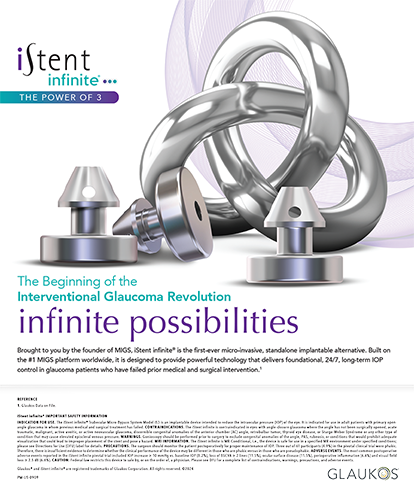The femtosecond laser for cataract surgery has ushered in unprecedented possibilities for the development of new surgical techniques.1,2 In November 2011, our practice in Nashville, Tennesee, acquired a LenSx Laser (Alcon Laboratories, Inc.), and since then, we have performed several hundred procedures using this new technology. Furthermore, we have been able to develop a new phaco-free, all-laser technique by taking advantage of the laser's unique ability to prechop the lens in a closed chamber in vivo and to soften the lens.
Charles Kelman, MD, developed phacoemulsification 30 years ago.3 However, despite significant technological improvements that have been made since then, phacoemulsification itself still remains one of the key causes of cataract surgery complications, such as posterior capsular breaks and corneal edema. If a technique can be developed to perform small-incision cataract surgery without the use of phacoemulsification, it will represent a significant improvement in cataract surgery. The phaco-free technique described here is one such example, made possible now with the availability of the femtosecond laser.
FOUR STEPS OF PHACO-FREE LASER CATARACT SURGERY
In this phaco-free technique, the first step is the creation of the capsulorhexis and the lens' fragmentation (a cylindrical cut and a crosshair lens cut) using the LenSx Laser. The second step is hydrodissection and the floating of the lens, as one piece, into the anterior chamber (Figure 1). The third step consists of cracking the laser-prechopped lens into small fragments using an opposing action of 180º with an ophthalmic viscosurgical device protecting the corneal endothelium (Figure 2). The fourth step is aspiration of the lens fragments and implantation of an IOL. We use a phaco tip (but without phaco energy) to aspirate lens fragments with the assistance of a second instrument. We have found that this new phaco-free technique can be used for a cataract of up to grade 3+ in density.
Discusion
Prior to the availability of the femotosecond laser to cut and soften the lens, it was difficult to crack the lens into fragments small enough to be aspirated directly without the use of phacoemulsification. We have been able to develop this phaco-free technique now by taking advantage of the laser's unique ability to prechop the lens in a closed chamber in vivo and to soften the lens tissue along the cut plane, greatly facilitating subsequent mechanical cracking. At deeper tissue levels, such as in the lens, the laser beam is less focused and more diffuse, resulting in larger cavitation bubbles. Although this is undesirable for a corneal procedure such as LASIK (ie, a 200-μm flap interface is much more coarse than that of a 100-μm flap), it is in fact a desirable feature of the laser for lens surgery. The larger cavitation bubbles increase the size of the volume of laser-tissue interaction via a plasma shock wave cavitation bubble mechanism and, as a result, soften the adjacent lenticular tissue along the cut plane, making this phacofree technique possible.
With regard to the pattern of laser lens fragmentation, we experimented with various designs. We found that although a lesser amount of lens fragmentation hindered subsequent mechanical cracking, an excessive amount on the other hand was also problematic. The latter creates too many cut planes in the lens tissue, which reduces the visibility of the capsulotomy edge and is thus potentially risky. We have optimized the laser parameters for this phaco-free method as follows: capsulotomy diameter = 5.25 mm, cylindrical lens cut diameter = 3 mm, and crosshair lens cut diameter = 5 mm. With regard to the energy setting for lens fragmentation, we found that the optimal range is 5 to 15 μJ, and we customize that to the lens' density to achieve optimal cutting and lens softening. We have found the optimal laser spot separation to be between 5 and 9 μm (horizontally) and 5 to 9 μm (vertically).
PEARLS FOR THE PHACO-FREE TECHNIQUE
For this phaco-free technique to work, the phaco tip's diameter needs to be as large as possible. The commonly used size is 0.9 mm in diameter; we use the largest commercially available size of 1.1 mm and are working on developing a 1.3-mm tip. In addition, traditional phaco chop techniques, such as the vertical chop, use two cracking instruments positioned on the same side of the lens and are thus less mechanically efficient. We have found that the 180º opposing action, in which two cracking instruments are positioned 180º from each other, is much more mechanically efficient. For aspiration, we use the highest vacuum level possible (650+ mm Hg).
CONCLUSION
By using the femtosecond laser, we have been able to develop a new cataract surgical technique, phaco-free laser cataract surgery. The femtosecond laser has already been shown to reduce the amount of phaco energy used, and we believe that elimination of phacoemulsification altogether may make small-incision cataract surgery safer and better for our patients. So 30 years after the introduction of phacoemulsification for small-incision cataract surgery, now with the femtosecond laser, we may be able to make phaco obsolete.
Ming Wang, MD, PhD, is a clinical associate professor of ophthalmology at the University of Tennessee, the director of Wang Vision Cataract & LASIK Center in Nashville, and the international president of Shanghai Aier Eye Hospital, Shanghai, China. He acknowledged no financial interest in the products or company mentioned herein. He wishes to thank Michael George, MD, for assistance in the preparation of this article. Dr. Wang may be reached at drwang@wangvisioninstitute.com.
- He L, Sheehy K, Culbertson W. Femtosecond laser-assisted cataract surgery. Curr Opin Ophthalmol. 2011;22(1):43-52. Review.
- Nagy Z, Takacs A, Filkorn T, Sarayba M. Initial clinical evaluation of an intraocular femtosecond laser in cataract surgery. J Refract Surg. 2009;25(12):1053-1060.
- Kelman CD. Phacoemulsification and aspiration. A new technique of cataract removal. A preliminary report. Am J Ophthalmol. 1967;64(1):23-35.


